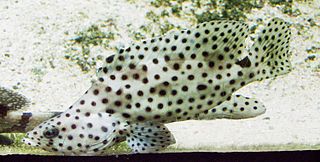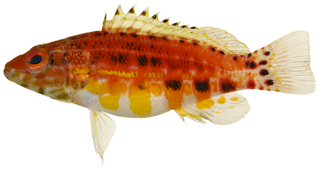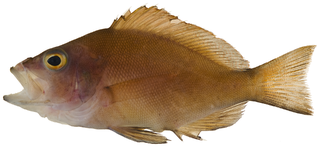
The Serranidae are a large family of fishes belonging to the order Perciformes. The family contains about 450 species in 65 genera, including the sea basses and the groupers. Although many species are small, in some cases less than 10 cm (3.9 in), the giant grouper is one of the largest bony fishes in the world, growing to 2.7 m in length and 400 kg (880 lb) in weight. Representatives of this group live in tropical and subtropical seas worldwide.

The wrasses are a family, Labridae, of marine fish, many of which are brightly colored. The family is large and diverse, with over 600 species in 81 genera, which are divided into 9 subgroups or tribes. They are typically small fish, most of them less than 20 cm (7.9 in) long, although the largest, the humphead wrasse, can measure up to 2.5 m (8.2 ft). They are efficient carnivores, feeding on a wide range of small invertebrates. Many smaller wrasses follow the feeding trails of larger fish, picking up invertebrates disturbed by their passing. Juveniles of some representatives of the genera Bodianus, Epibulus, Cirrhilabrus, Oxycheilinus, and Paracheilinus hide among the tentacles of the free-living mushroom coral Heliofungia actiniformis.

Gobiidae is a family of bony fish in the order Gobiiformes, one of the largest fish families comprising more than 2,000 species in more than 200 genera, sometimes referred to as the "true gobies". Most of them are relatively small, typically less than 10 cm (3.9 in) in length. The Gobiidae includes some of the smallest vertebrates in the world, such as Trimmatom nanus and Pandaka pygmaea,Trimmatom nanus are under 1 cm long when fully grown,then Pandaka pygmaea standard length are 9mm ,maximum known standard length are 11 mm. Some large gobies can reach over 30 cm (0.98 ft) in length, but that is exceptional. Generally, they are benthic, or bottom-dwellers. Although few are important as food for humans, they are of great significance as prey species for commercially important fish such as cod, haddock, sea bass, and flatfish. Several gobiids are also of interest as aquarium fish, such as the dartfish of the genus Ptereleotris. Phylogenetic relationships of gobiids have been studied using molecular data.

Groupers are fish of any of a number of genera in the subfamily Epinephelinae of the family Serranidae, in the order Perciformes.

The hogfish, is a species of wrasse native to the western Atlantic Ocean, with a range from Nova Scotia, Canada to northern South America, including the Gulf of Mexico. This species occurs around reefs, especially preferring areas with plentiful gorgonians. This species is currently the only known member of its genus.

The ocellaris clownfish, also known as the false percula clownfish or common clownfish, is a marine fish belonging to the family Pomacentridae, which includes clownfishes and damselfishes. Amphiprion ocellaris are found in different colors, depending on where they are located. For example, black Amphiprion ocellaris with white bands can be found near northern Australia, Southeast Asia, and Japan. Orange or red-brown Amphiprion ocellaris also exist with three similar white bands on the body and head. Amphiprion ocellaris can be distinguished from other Amphriphon species based on the number of pectoral rays and dorsal spines. Amphiprion ocellaris are known to grow about 110 mm long. Like many other fish species, females are, however, larger than males. The life cycle of Amphiprion ocellaris varies in whether they reside at the surface or bottom of the ocean. When they initially hatch, they reside near the surface. However, when Amphiprion ocellaris enter into the juvenile stage of life, they travel down to the bottom to find shelter in a host anemone. Once they find their anemone, they form a symbiotic relationship with them.

Anthias are members of the family Serranidae and make up the subfamily Anthiadinae. Anthias make up a sizeable portion of the population of pink, orange, and yellow reef fishes seen swarming in most coral reef photography and film.

Sparisoma is a genus of parrotfishes native to warmer parts of the Atlantic. FishBase recognizes 15 species in this genus, including S. rocha described from Trindade Island in 2010 and S. choati described from the East Atlantic in 2012. They are the main grazers of algae in the Caribbean since sea urchins, the former main grazers, experienced a mass extinction and were supplanted by the parrotfishes.

The bicolor angelfish is a marine species of fish, easily recognizable by its yellow tail, yellow front half of their body, and blue rear with blue patterns above and around the eye. This angelfish is also commonly known as: Pacific rock beauty, oriole angelfish, oriole dwarf angel, blue and gold angel, and two-colored angel. The average life expectancy is 5–13 years, depending upon its location. These fish tend to grow to a maximum of 6 inches in length, making them a dwarf fish.
The tiger grouper is a benthic marine fish which belongs to the family Serranidae or also known as the groupers.

Serranus is a genus of fish in the family Serranidae. It is one of five genera known commonly as the "Atlantic dwarf sea basses". These fish are hermaphrodites, each individual possessing functional male and female reproductive tissues. When a pair spawns, one fish acts as a male and the other acts as a female.

The black jack, Caranx lugubris, is a species of large ocean fish in the jack family Carangidae. The species has a circumtropical distribution, found in oceanic, offshore waters of the tropical zones of the Pacific, Atlantic and Indian Oceans. The species is particularly prevalent around offshore islands such as the Caribbean islands in the Atlantic, Hawaii and French Polynesia in the Pacific and the Seychelles and Maldives in the Indian Ocean. Black jack are rare in shallow waters, preferring deep reefs, ledges and seamounts in clear waters. The species is easily distinguished by its black to grey fins and jet black scutes, with the head having a steep profile near the snout. The largest recorded length is 1 m and weight of 17.9 kg. The black jack lives either individually or in small schools, and is known to school with other species. It is a predatory fish, taking a variety of fish, crustaceans and molluscs as prey. Sexual maturity is reached at 34.6 cm in females and 38.2 cm in males, with spawning taking place between February and September in the Caribbean. The early life history of the species is very poorly understood. Black jack are of high importance to many island fisheries, but are rarely encountered in most continental fisheries. The species has a reputation as a gamefish, and is variably considered a terrible or excellent food fish, although several cases of ciguatera poisoning have been attributed to the species. The species was initially named Caranx ascensionis by Georges Cuvier, however several issues with the use of this name have seen Felipe Poey's name Caranx lugubris become the valid scientific name.

Snappers are a family of perciform fish, Lutjanidae, mainly marine, but with some members inhabiting estuaries, feeding in fresh water. The family includes about 113 species. Some are important food fish. One of the best known is the red snapper.

Hypoplectrus nigricans, the black hamlet, is a hamlet in the family Serranidae. It is native to shallow parts of the central Western Atlantic Ocean and Caribbean Sea. It grows to about 15 cm (6 in) in total length. It is a simultaneous hermaphrodite, with a breeding strategy known as egg trading. One fish acts as a female and lays a batch of eggs which the other fertilises. The following night, the roles are reversed.

The bird wrasse, Gomphosus varius, is a species of the wrasse family.

The honeycomb grouper or dwarf spotted rockcod, also known by other vernacular names, is a species of marine fish in the family Serranidae.

The yellowhead wrasse, Halichoeres garnoti, is a fish species belonging to wrasse family native to shallow tropical waters in the Caribbean Sea and western Atlantic Ocean.

The creole wrasse is a species of wrasse native to the western Atlantic Ocean.

Haemulon is a genus of fish in the grunt family known as the scaled-fin grunts. Most are found in the western Atlantic Ocean, with a few species known from the eastern Pacific Ocean. This genus is considered to be one of the most important fish groups of the coral reefs of Brazil due to its commercial value and crucial ecological role.

























